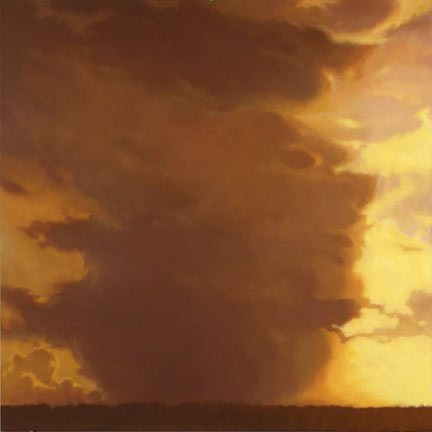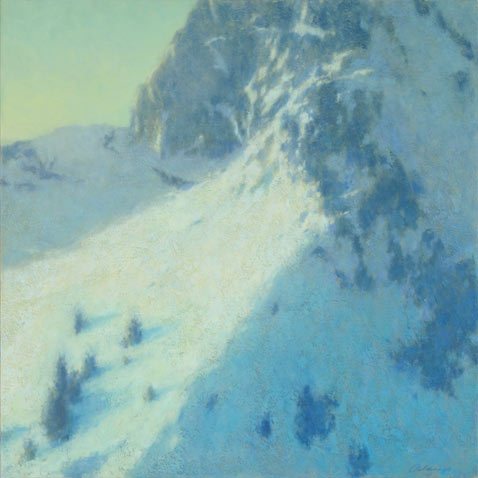Painting the Illusion of Distance


Is It Just About Learning My Perspective Drawing Lessons?
This summer I’ve set myself the goal of traveling a bit more to take advantage of the season and soak up Mother Nature at her balmiest. When I go to the beach or camp out over a long weekend, I often try to sketch while I’m out. I often notice that trying to create the illusion of space—over valley peaks or a body of water—can be difficult! The distance over water is sometimes deceptive and the atmospheric effects of air, light, and cloud cover in a valley can really distort what I see despite trying to start with a perspective drawing of some sort and building on that.
Yes, you can solve some of these problems with a sound knowledge of perspective drawing. That is key for any sense of proportion in landscape artwork. But you can also get a good sense of the space from where you stand to the object in the distance a few other ways.
Reducing and Massing
Bringing together the forms, textures, colors, and details you see in the distance helps make for a less fussy work, and effectively recreates the way the eye sees. When an instructor says “squint,” they usually mean reduce and mass.
Use Scale to Your Advantage
This is a tried-and-true visual cue for artist and viewer alike. I know it seems elementary, but it bears repeating: the larger the object, the closer we think it is to us.

Front, Middle, Back
A well-defined fore-, middle-, and background are also really crucial when painting water or vast stretches of an object or place that is fairly uniform. It might be that the texture you see in each of these areas changes with the distance implied. But it could also be color or painting light effects as they rest on different forms. It all depends on how you want to break up the space.
I got these atmospheric landscape painting tips from the artist Mitchell Albala, but for true, clear perspective drawing lessons, I recommend Phil Metzger’s Perspective Without Pain. Sounds wonderful, doesn’t it? And it really is, in terms of being a readable guide with plenty of great visual examples, and from an author who is foremost an artist–so I know his advice is in keeping with where I want to go with my own work. I hope it is the same with you. Enjoy!
And where are you headed this summer? What challenges and triumphs might you encountered with your painting and drawing? Leave a comment and let me know so we can find solutions together!






omigosh! How do you do it? I run into a problem, and BINGO! The next day uou post a blog giving me a critical tip. You are amazing, though I do wonder if you have some sort of crystal ball…… LOL
I just came back from a plein air trip in which i had to paint the Siusun Bay from the Elk preserve on Hwy 38 out of Reedsport, Or. My dilemma was that there was little to lend itself to easy perspective cues. It was a combination of the texture and making the foreground middle and distance clearly different that really helped.
PS This is not the first time you spoke to me right where I needed to be! Thank you so much for your well-written, right-on insights.
Being of the same background as Folk Heart I would like to echo her comments, this is indeed another great topic, Courtney, many thanks. Now with what part of the summer is left I am going to acquire and study Mitchell Albala’s book, Landscape Painting.
Doc
Thank you for this info as I recently went through this situation. I decide to pack up my paints and easel and take the show on the road for the first time. As much as it was fun, it was also very frustrating since I had never done this before. The results were interesting and I have decided this is something to be explored further. when I complete the painting I will post it. Until then Thank You for all the insights posted.
I have always struggled with value/color/line and knowing what colors to use for the foreground/middle/distance in my paintings. This summer I found a mentor. I got interested in digital art and illustration for childrens ebooks. I found the website willterry.com later changed to http://www.folioacademy.com and purchased his homevideos with step by step instructions for this area of my interest.
My perspective drawings have been off so I also purchased one of his newer videos on “Beginning Perspective Drawing” I had assumed I missed that class that day and perhaps a review would help. Part four of the video is listed as “Atmospheric Perspective” After watching it the light bulb in my head finally went on and I can now choose my colors for a landscape with distant mountains etc in them. I never truly understood value and how to create it, not to mention color and line. In fifteen minutes of watching their Adobe Photoshop demo, I now know that there were always only three colors of the foreground (lights) used in the middle and distance but with certain amounts of grey/black added as you go back into the distance. The mountains in the farthest distance only had two light color swatches when blown up to pixel size.
If you are a visual learner this is a brilliant depiction of this lesson on values/color/fuzzy vs. sharp lines and how to paint things far away. It was also a great brush up on my perspective. Well worth the twelve or so dollars I spent for it.
Spent time this summer along the coast of Maine. The coastal areas of Boothbay Harbor, Bar Harbor, Acadia National Park, and Scoodic Point, which is also a part of the park are an artist’s paradise and dream. I had opportunities to paint water in its many varying appearances, and that is always a huge challenge. Trees, rocks, water, and beautiful skies. What more could a plein aire painter desire. People visiting these areas were curious about what I was doing and approached me and asked questions. I thought beforehand that I would be put off by this, but when I young children approached and ask questions out of innocent curiosity I decided to go with the flow. Truly, I was blessed that others were interested in what I was doing. I did not find the presence of others as intrusive as I thought I would.
Getting that sense of vastness is challenging, but Mitch Albala does an amazing job. I purchased this book, Landscape Painting, about 2 years ago and I absolutely love it. I highly recommend it – easy to read, great artwork, and it makes sense. It has helped my paintings progress, and I reference it (and bring it) when I teach.
As a self-taught artist, I must say that this subject is one that I have found most challenging over the years. In my teens I painted a scene from a fishing village on the east coast. Although I used a photo, and replicated it in the most realistic manner, it lacked depth. It may be time to revisit that painting! Thank you so much for all of the wonderful posts and tips. I look forward to your emails more than anything.
I’ve been trying to brush up (get it!?) on my plein air landscape skills to get ready for a trip this fall, and the illusion of distance is a stumbling block for me – I always end up getting too fussy. I’m thinking of restricting myself to nothing but a 2″ brush for a 5×7″ piece of paper and seeing if that helps!